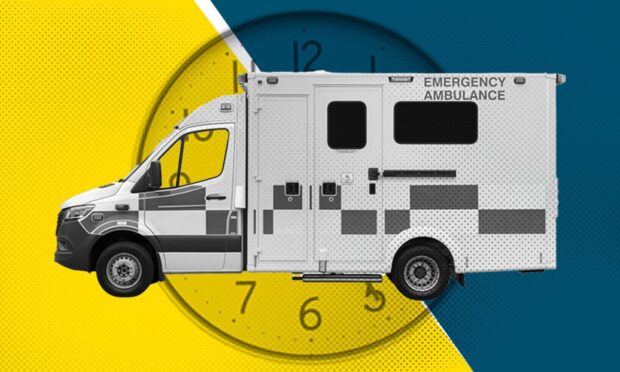Nine in ten ambulances are queuing outside Aberdeen Royal Infirmary for up to nearly four-and-a-half hours with potentially fatal consequences, a whistleblower has warned.
In-demand ambulances are getting stuck outside the overwhelmed hospital, preventing crews from responding to other 999 calls and impacting response times.
It’s claimed that patients’ conditions are deteriorating while waiting for ambulances to arrive or for NHS Grampian to take them into the care of their doctors and nurses.
“People are dying and getting harmed,” a Scottish Ambulance Service (SAS) insider told The Press and Journal.
The chilling comments came after the north-east’s hospitals failed to turn around 90% of ambulances within just under two hours, an ambitious target bosses had set themselves to achieve by the end of March.
However, the current performance remains around two-and-a-half times that 110-minute figure.
A SAS spokeswoman branded the lack of progress “extremely disappointing” while NHS Grampian insisted that patient safety was its “highest priority”.
‘Our emergency vehicles are used as hospital waiting areas’
Earlier in the year, this newspaper launched an investigation into the availability of ambulances.
“It’s out of our control while our emergency vehicles are used as hospital waiting areas,” a source explained.
They described the ambulance stacking as “a real challenge” for frontline medics, adding: “You just have to see what you can do with what you have.
“The people being harmed aren’t so much the life-threatening purple and red [grade] call patients. It’s the lower-grade or less urgent calls (green, yellow, and amber).
“Sometimes it’ll be 14-18 hours before they’re picked up.”
One recent ambulance patient, a single dad-of-five from Dyce, believed he was having a heart attack when he called 999 at 2.35am last Wednesday.
Gary Dow, 55, said: “I was finding it hard to breathe with a crazy pain in my chest and pins and needles down my arm.”
He told us the SAS call handler asked if he could get himself to Aberdeen Royal Infirmary.
“The operator said, ‘Can you either make your own way to the hospital by taxi or get some of your friends to take you?'” he recalled.
“I couldn’t contact friends at three o’clock in the morning, and I’ve got no family apart from my children.
“I was scared and worried about them losing their father.”
An ambulance eventually arrived to take Mr Dow to ARI and he arrived there at 3.32am – however it wouldn’t be until 11.33am that he was taken inside for treatment.
The emergency vehicle was the fifth to join a queue of six outside ARI’s emergency department.
“There were no beds available in the hospital for new patients,” he explained. “The wait to get into the hospital was a joke.
“I was in the back of an ambulance for eight hours before I was taken in and treated.”
Thankfully, Mr Dow did not have a heart attack, a blockage of the blood supply to the heart, and he never suffered a cardiac arrest.
However, Mr Dow insisted that NHS Grampian staff used the words “heart attack” and “blockage” when explaining what had happened to him.
‘How many people won’t make it through if this continues?’
The heart episode was caused by a narrowing of an artery in the wall of his heart, which restricted the blood flow, a condition that can lead to a heart attack over time.
He was eventually fitted with a single stent, a wire mesh tube that acts like a scaffold to widen the restricted artery and help to keep it open.
Mr Dow said he “could not fault” the “lovely” ambulance crew and “excellent” hospital workers.
However, he slammed the delay in being taken into the hospital for the potentially life-saving treatment.
He said: “I’m lucky I made it through, but this situation needs to be fixed. How many people won’t make it through if this continues?”
Our investigation’s findings
The Dyce dad’s troubling experience was far from a one-off occurrence at ARI, where the long-running issue of ambulance stacking is worsening, according to official data.
Using Freedom of Information legislation, The Press and Journal obtained ambulance hospital turnaround times across Scotland.
It revealed that one ambulance was tied up at ARI for 15 hours in the week beginning January 6.
Dr Gray’s Hospital in Elgin recorded a delay of almost 12-and-a-half hours in the week beginning February 24.
Our investigation found:
- ARI ambulance turnaround times were more than twice that of other large Scottish hospitals (including QEUH, ERI, GRI, Ninewells).
- Only four hospitals exceeded four hours turnaround, including ARI and Dr Gray’s, and ARI was the worst offender.
- NHS Grampian took the longest of all 14 Scottish health boards to turn around ambulances last year.
- Over half of Scotland’s longest ambulance turnaround times recorded in 2024, six of them, occurred at NHS Grampian hospitals.
An NHS Grampian spokeswoman said: “It is also important to note that the longest ambulance turnaround times are not indicative of the time taken for emergency cases to be seen.”
The health board records the handover time, from when an ambulance patient is booked in to when they are triaged.
The P&J invited it to share any data contradicting our investigation’s findings, however, none has been provided.
An official conceded that their figures do not differ significantly from the SAS’s turnaround data.
That measures the time between an ambulance’s arrival at the receiving site and when it is available to respond to another call.
The figure includes cleaning or restocking an ambulance at the hospital after the NHS takes over responsibility for the crew’s patient.
Most ambulances require only a 10-15 minute wipe down.
However, the turnaround clock stops when some kit needs to be replenished or a one-hour deep clean is required following a major trauma, because those tasks are carried out back at ambulance stations.
And on only some occasions, crews are delayed leaving the hospital when required to give police statements.
When NHS Grampian was asked to comment on why nine in ten ambulances are taking up to four hours and 25 minutes to be turned around at its hospitals, what is referred to as the 90th percentile, a spokeswoman instead pointed our reporter to a more favourable calculation.
“The median turnaround time for ambulances in Grampian is just over one hour, which we will continue to work hard to reduce,” she said.
NHS Grampian receives approximately 98,000 visitors to its emergency department every year and admits 100,000 patients, as well as offering 1.2 million outpatient appointments annually.
There were over 1,200 respondents to the questionnaire, with 244 claiming they had either called an ambulance or had one called for them in the past 12 months.
More than a quarter of them (28.8%) across the north and north-east waited over an hour for the ambulance to arrive.
Among the respondents registered with the NHS in the Grampian region, around six in 10 who expected an ambulance said it arrived within an hour.
Over half of them did not have to wait before their hospital admission.
The P&J also captured anecdotal evidence shared by survey participants and followed up by interviewing them.
An advanced nurse practitioner in the Grampian region, who asked not to be named, spoke about her frustration.
“I see people who are acutely unwell in the community, either in a GP practice or during home visits,” she said.
“I often need to call a one-hour ambulance for patients,” she explained, before complaining about “significant delays for almost all patients”.
Nurse speaks out about patients’ 12-hour waits in ambulances at A&E
One included an elderly woman with suspected sepsis, a potentially life-threatening infection that can lead to multiple organ failure and death.
The experienced nurse said the SAS told her that the patient, who had suffered sepsis before, would have to wait “a minimum of four hours” for an ambulance to turn up.
“A four-hour wait for an ambulance could have turned the lady’s condition life-threatening,” the health professional said.
“She was okay enough to wait up to an hour, but for a suspected sepsis patient, a four-hour ambulance wait can’t happen.
“I had to upgrade the lady to an emergency ambulance because I wasn’t happy for her to wait over an hour, but they’re meant for people having a stroke or heart attack, patients needing resuscitation, or people having difficulty breathing.”
The clinician added: “My patients are reporting up to 12-hour waits in the ambulance once they reach A&E.”
Bed blockers blamed for shortage at ARI
In Spring 2023, an NHS Grampian review identified a “shortfall in bed capacity” at ARI.
The need for an additional 120 beds was identified.
However, the report published in August last year, also stated that “approximately 40%” of bed occupants were found to be “in the wrong place”.
It highlighted the issue of delayed discharges, hospital inpatients who no longer require hospital treatment and are ready to be discharged, but remain in the beds anyway.
The Bed Base Review found a “rough average” of 200 NHS Grampian beds in July 2024 that were not being used properly.
Almost a year later, the dial has barely shifted with insiders estimating between 180 and 190 of its hospital beds across the region are occupied by the so-called bed blockers at any one time.
A highly qualified Grampian community care worker told our survey: “In the hospitals, you have patients waiting for care in the community for months and that’s blocking hospital beds.
“I know of at least one patient at ARI who waited nine or 10 months for a bed in the community and during that time they caught several hospital-acquired infections.”
Efforts are limited by tightening budgets and the pressures of an ageing population – Health and Social Care Partnerships
A key issue standing in the way of reducing the bed-blocking figure is patients who lack the capacity to give consent.
They include people who do not have a Power of Attorney arranged, significantly delaying the receipt of the right care and support within the community.
A spokesman for the Aberdeen City, Aberdeenshire and Moray Health & Social Care Partnerships, said they were trying to do their bit to reduce delayed discharges to ease ambulance stacking at hospitals.
He said: “There are many reasons why someone may find themselves classed as a delayed discharge, the most common factors include a shortage of suitable care home places and care at home packages, a lack of adapted housing and limited community or family support.
“While some people are waiting in acute and community hospitals for support to return home, we also have individuals and families in the community who are waiting for their care needs to be met.
“Our teams are working hard to mitigate these challenges and are collaborating closely with our external care providers. However, these efforts are limited by tightening budgets and the pressures of an ageing population.”
‘We recognise the public’s concern and frustration’
An SAS spokeswoman said: “We recognise the public’s concern and frustration.
“It is extremely disappointing that despite extensive engagement with NHS Grampian, hospital delays at Aberdeen Royal Infirmary and Dr Gray’s Hospital continue to put significant pressure on the ambulance service across Grampian.
“These delays prevent our ambulance crews from getting back out on the road to treat other patients and can impact our ambulance response times.”
Reacting to that statement, a spokeswoman for NHS Grampian said: “We share the concern of patients and staff and will continue to work closely with the Scottish Ambulance Service to reduce ambulance turnaround times.
“Our clinical staff are now providing support to assess patients while in ambulances, and our Call Before You Convey service and Flow Navigation Centre prevent patients from being transported to hospital by ambulance when other treatment pathways should be followed.
“The safety of patients, our staff, and those working for SAS has the highest priority.
“In the event an ambulance needs to be released urgently to attend an emergency call, we have protocols and systems in place to allow the rapid release of SAS vehicles.”
‘Ambulances are not hospitals’
In February last year, we reported that up to half the north-east’s ambulance fleet, as many as 18 ambulances, were “stuck” outside ARI because too many people had gone to a hospital with too few beds, according to a whistleblower at the time.
That month, the SAS carried 2,699 patients to Grampian hospitals, with 90% of those ambulances waiting up to almost three and a half hours (three hours, 27 minutes) to be turned around.
Around nine months later, in November last year, the SAS chief executive, Michael Dickson OBE, said it was “disappointing” that “little meaningful progress” had been made to fix Aberdeen’s ambulance queues crisis despite working “extensively” with NHS Grampian.
“Ambulances are not hospitals, he told this newspaper at the time, and admitted: “It’s not a place you want to spend many hours in.”
The delays have already been exposed by high-profile incidents in which ambulances were unavailable when needed during emergencies.
In March last year, a baby who was rescued from a deadly fire at a block of flats on Back Hilton Road in Aberdeen had to be taken to the hospital by police because an ambulance couldn’t get to the scene due to delays.
The SAS blamed “lengthy hospital turnaround times”.
That month, the emergency service carried 2,861 north-east patients, with 90% of their ambulances facing delays of up to 197 minutes/three hours and 17 minutes.
No ambulances available when baby knocked down by vehicle
In May, no ambulances were available to respond to one-year-old Ivy Mae Ross, from Whitecairns, who died after being knocked down by a vehicle outside the Plymouth Brethren Church on Eigie Road, Balmedie.
Ambulances were “stacked” outside Aberdeen Royal Infirmary and waiting “in excess of five hours” to pass patients over to hospital staff.
An alternative specialist ambulance crew had to be deployed instead, arriving at the scene in 11 minutes.
That month, 2,962 ambulance patients were conveyed across Grampian, and nine in every 10 of the ambulances were up against turnaround times as long as 196 minutes/three hours and 16 minutes.
Scottish Government responds
There is a “long-term aim” for ambulance patients to be handed over for hospital care within 15 minutes.
The seemingly unrealistic target was stated in an April 2023 document published on the Scottish Government’s website.
It stated that a patient “should not queue (cohorting, holding area or ambulance) for greater than 1 hour” and should be “fully handed over and care transferred to the department clinical team thereafter”.
It added that by August 2023, “100% of patients should be handed over within 60 minutes”.
The Press and Journal asked Health Secretary Neil Gray to comment on our investigation.
Instead, the Scottish Government sent a statement.
Such delays are not unique to Scotland with similar pressures throughout the UK – Scottish Government
It read: “We are aware of the ongoing challenges with the handover of patients at hospital sites in Grampian.
“Such delays to hand over patients at emergency departments are not unique to Scotland, with similar pressures being felt throughout the UK.
“We are working closely with NHS Grampian and the Scottish Ambulance Service to ensure appropriate actions are in place to support the safe transfer of patients upon arrival at hospital.
“To help relieve pressure on A&E and reduce waiting times, we are investing £200 million to support the delivery of our Operational Improvement Plan.
“This plan focuses on shifting the balance of care from acute to community through measures such as increasing access to specialist frailty teams in every emergency department by summer 2025 and expanding hospital at home to at least 2,000 beds by the end of 2026.”




Conversation